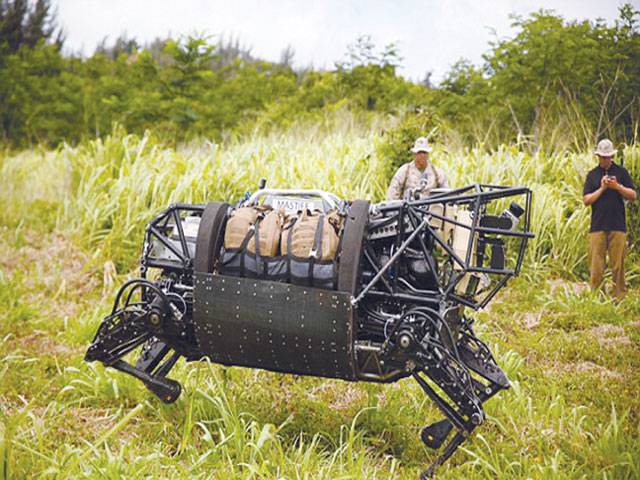MOL
Hawaii
A Google owned robot called ‘big dog’ is being tested in its first live military trial with Marines in Hawaii. Officially known as the ‘Legged Squad Support System’, it has taken five years to develop.
It can walk and run over rugged terrain, following a soldier while carrying 400lbs of their kit and weapons. It is now being thrown into the Kahuku Training Area - completely controlled and field tested by five young Marines from India Company, 3rd Battalion, 3rd Marine Regiment. The LS3 is a robotic mule, capable of traversing rugged terrain with Marines while carrying much of their load. It is programmed to follow an operator and detect large terrain objects to maneuver around. The testing for the LS3 is being observed by the Marine Corps Warfighting Lab during the Advanced Warfighting Experiment as part of Rim of the Pacific 2014, a military multilateral training event featuring 22 nations and roughly 25,000 people. Lance Cpl. Brandon Dieckmann, a Las Vegas soldier, was given the task of controlling Cujo. - and admits he remembers watching clips of the LS3 on Youtube before he joined the infantry.
He said he never would have guessed he would be chosen to operate the machine, which has been affectionately nicknamed ‘Cujo’ by his company.
‘The reality (is that it’s) a walking robot and quadrupedal robotic legs are something that can be done (stood out to me),’ Dieckmann said. ‘They randomly chose us to operate it, probably because I wear glasses.’ The Marines used ‘Cujo’ to conduct resupply missions to the various platoons around the training area.
The LS3 brought water to service members in terrain difficult to reach by all-terrain vehicles. ‘I was surprised how well it works,’ Dieckmann said. ‘I thought it was going to be stumbling around and lose its footing, but it’s actually proven to be pretty reliable and pretty rugged. It has a bit of a problem negotiating obliques and contours of hills.’
The LS3 is being used as a logistical tool during RIMPAC as opposed to a tactical tool, due to its loud noise during movement and problems traversing certain terrains. ‘I’d say 70 to 80 percent of the terrain we go through, it can go through,’ Dieckmann said. ‘There are times when it is going to fall over, but most of the time it can self-right and get back up on its own.
‘Even if it doesn’t, it can take one person to roll it back over. The way it is designed is that you can easily roll it back over.’ Huberth Duarte, an infantryman with India Co., 3/3, and an operator for the LS3, says the robotic mule has become like a dog to him.
Friday, April 19, 2024
Google’s robot dog goes on patrol with marines

Caption: Google’s robot dog goes on patrol with marines
US vetoes Palestine’s bid for full UN membership
8:27 AM | April 19, 2024
20pc Discos employees involved in power theft: Minister
April 19, 2024
Five govt officials shot dead in D I Khan
April 19, 2024
Parvez Elahi’s indictment delayed again in two cases
April 19, 2024
Hepatitis Challenge
April 18, 2024
IMF Predictions
April 18, 2024
Wheat War
April 18, 2024
Rail Revival
April 17, 2024
Addressing Climate Change
April 17, 2024
Justice denied
April 18, 2024
AI dilemmas unveiled
April 18, 2024
Tax tangle
April 18, 2024
Workforce inequality
April 17, 2024
New partnerships
April 17, 2024
ePaper - Nawaiwaqt
Advertisement
Nawaiwaqt Group | Copyright © 2024





